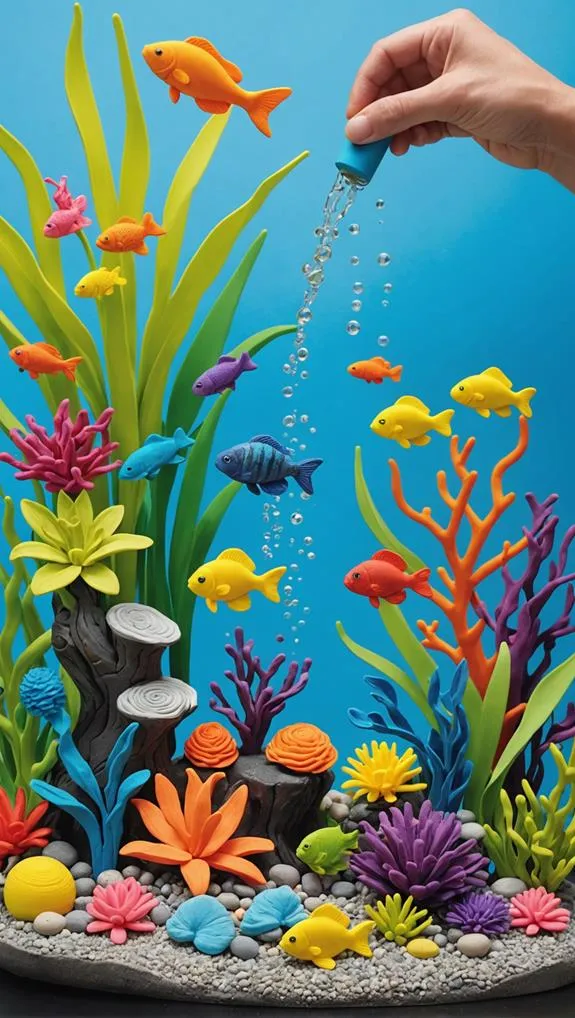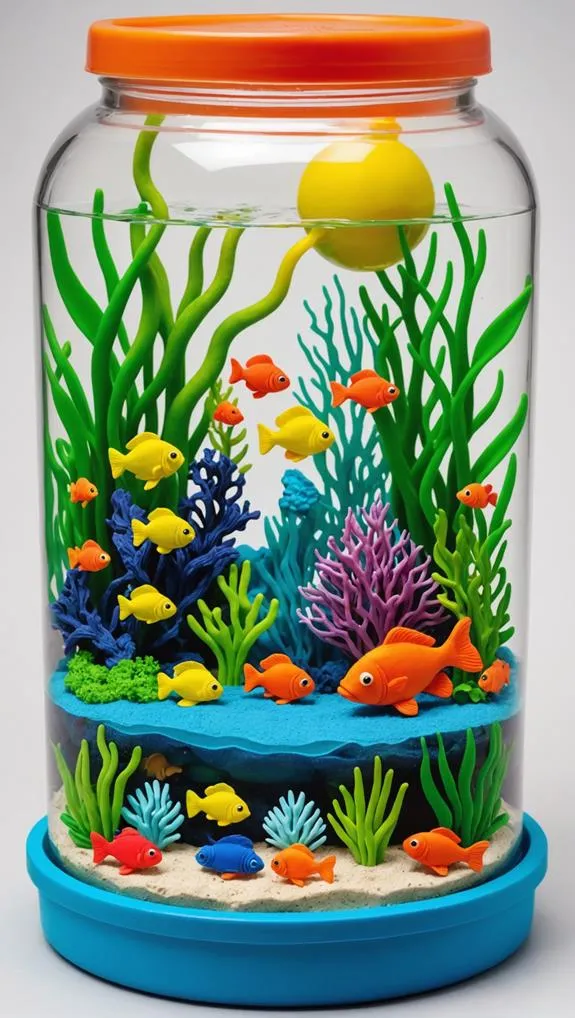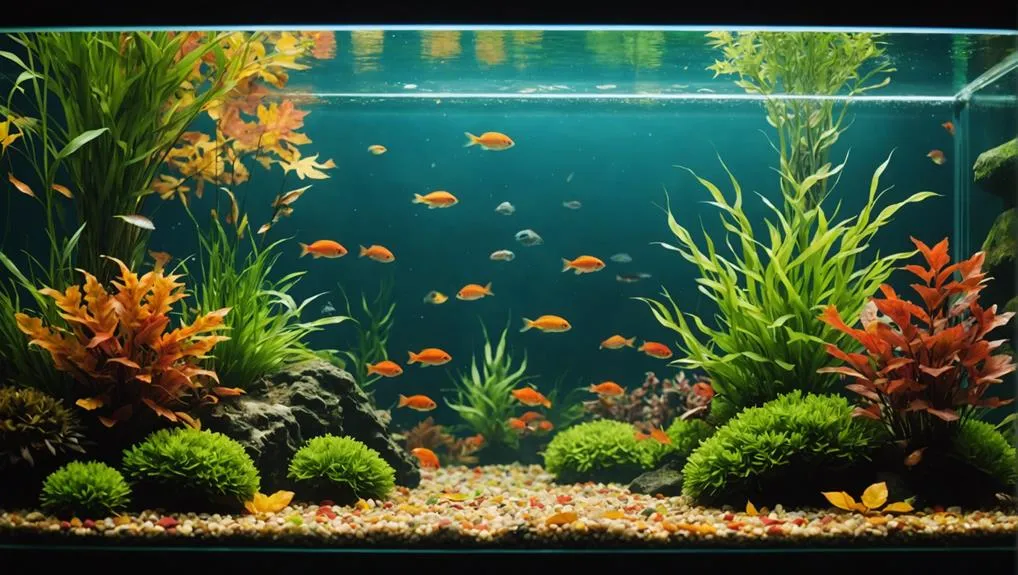Cleaning your fish tank this fall is crucial for keeping your aquatic buddies healthy and happy. Start by checking your water quality—keeping ammonia and nitrite at zero and nitrates under 40 mg/L is key! Next, aim for partial water changes of 10-15% weekly, and use a siphon to vacuum out debris. Don't forget to scrape that pesky algae off the glass! Regularly check your filter too, since a well-maintained filtration system is vital. With these tips, your fish tank will shine brighter than your cousin's new tattoo! Stick around, and you'll discover more easy care techniques for your aquatic haven!
Contents
Importance of Regular Cleaning
Regular cleaning is crucial for maintaining a healthy aquarium ecosystem. When you clean your fish tank regularly, you help ensure optimal water quality. This means removing harmful waste and toxins that could jeopardize your fish's health and overall happiness.
Plus, cleaning is essential for supporting beneficial bacteria that play a vital role in the nitrogen cycle stable nitrogen cycles. These little helpers convert toxic ammonia into less harmful nitrates, keeping your aquatic friends swimming happily.
By making regular cleaning a priority, you're also reducing the risk of diseases. Harmful bacteria, fungi, and parasites love unclean environments, and we don't want to roll out the welcome mat for them! A clean aquarium not only keeps your fish healthy but also creates a clear, visually pleasing space that you and your guests can enjoy.
Don't forget about those water changes! They're key to removing debris and maintaining a balanced environment. Scheduled cleaning can even prevent clogged filters and equipment malfunctions, saving you from costly repairs.
Seasonal Water Quality Checks
As autumn settles in, it's essential to conduct seasonal water quality checks to keep your aquarium thriving. Regularly monitoring the water ensures a safe and healthy environment for your freshwater fish.
Maintaining optimal water quality parameters is key to preventing potential health issues and ensuring the well-being of your aquatic pets. After all, happy fish means happy you!
Here's what you should focus on during your checks:
- pH Levels: Aim to keep your pH between 6.5 and 8.2. This range is crucial for your fish's health.
- Nitrates and Ammonia Levels: Test regularly to ensure ammonia and nitrite levels are at 0 mg/L, while nitrates shouldn't exceed 40 mg/L. Too much can stress your fish!
- Alkalinity and Chlorine Levels: Maintain alkalinity between 120-300 mg/L to stabilize pH. Also, ensure chlorine and chloramine levels are undetectable, especially if using tap water.
Regular testing is vital for early detection of water quality issues, helping to keep your fish safe and healthy. Reliable test kits should be used to accurately monitor these parameters.
Effective Cleaning Techniques

How can you ensure your fish tank stays clean and healthy? Start by sticking to a solid maintenance schedule. Aim for partial water changes of 10-15% every week to improve water quality by reducing ammonia and nitrites. This helps prevent toxin buildup and keeps that water quality sparkling!
While you're at it, grab a siphon and get to vacuuming the gravel. It's a great way to remove debris without disturbing those vital beneficial bacteria that keep your tank thriving, which supports fish health through regular maintenance routines.
Don't forget about algae! Regularly scrape it off the aquarium glass with an algae pad or scraper. A clear view boosts your fish's happiness and enhances your tank's charm.
When it comes to decorations, simply wipe them down with aquarium-safe products—no soap or harsh chemicals, please!
And while we're talking about maintenance, remember to rinse your filter media gently in the siphoned aquarium water during water changes. This preserves your beneficial bacteria, crucial for that nitrogen cycle.
Maintenance of Filtration Systems
What steps are you taking to keep your filtration system in top shape? A well-maintained filter is essential for a healthy tank, ensuring clean water and a thriving habitat for your fish.
Regular maintenance is key, and here are three important tasks to keep in mind:
1. Monthly Check-Up: Rinse or replace your filter media at least once a month.
Use aquarium water to preserve those beneficial bacteria that support the nitrogen cycle. You don't want to start from scratch!
2. Flow Rate Monitoring: Take a moment each month to check your filtration system's flow rate.
Clean any obstructions in the intake to ensure consistent water circulation. Think of it as giving your filter a little workout!
3. Inspect Components: Regularly check seals and hoses for wear and tear.
Replace them as needed to prevent leaks. After all, a leak isn't a great surprise for anyone!
Fish Health and Feeding Tips

When it comes to keeping your fish healthy, a balanced diet is key, just like it's for us!
Make sure to feed them a mix of flakes, pellets, and even some tasty treats like frozen worms—variety is the spice of life, right?
Also, remember to follow a feeding schedule that suits them, and don't hesitate to skip a day every now and then; they won't throw a fishy tantrum!
Balanced Diet Importance
Ensuring your fish get a balanced diet is key to their health and vitality. Just like us, fish thrive on variety!
It's essential to provide different types of food to meet their specific dietary needs. Here are three important tips to help you achieve this:
- Mix It Up: Incorporate a variety of fish food, such as flakes, pellets, and even frozen or live options. This caters to different fish species and keeps meals exciting!
- Control Feeding: To avoid overfeeding, limit portions to what your fish can consume in one minute. It's also a good idea to skip feeding once a week. Think of it as a little fishy fasting—great for digestion!
- Choose Quality: Always opt for high-quality fish food that contains essential vitamins and minerals. This supports your fish's immune health and helps prevent disease.
Regularly observing your fish during feeding can help you catch any signs of stress or dietary issues.
Remember, a balanced diet doesn't just keep your fish healthy; it keeps your aquarium thriving!
Feeding Frequency Guidelines
Finding the right feeding frequency for your fish is crucial for their overall health and well-being.
You'll want to stick to feeding them small amounts that they can finish in about a minute, usually one to two times a day. This helps prevent overfeeding, which can lead to uneaten food and water contamination—definitely not what you want for a healthy habitat!
It's also a great idea to vary their diet. Mixing things up with flakes, pellets, and maybe even some frozen or live food will keep your fish happy and healthy.
Remember, different fish have different natural feeding habits, so take a moment to learn about the specific needs of the fish you keep.
Consider skipping a meal once a week; it might sound harsh, but it can actually boost your fish's health and improve the aquarium conditions.
Keep an eye on their behavior during feeding—if you see stress or leftover food, it might be a sign of overfeeding or that the diet isn't quite right.
Monitoring Temperature and Lighting
To maintain a healthy aquarium environment, it's essential to monitor both temperature and lighting closely. Keeping an eye on these factors ensures your fish thrive and stay stress-free. Here's a quick guide to help you:
1. Use a reliable aquarium thermometer: Check the water temperature daily. Aim for a stable range of 74-82°F (23-28°C). Sudden fluctuations can really stress your fish and mess with their immune systems.
2. Control lighting conditions: Provide 10-12 hours of light each day. This helps your fish and plants flourish while keeping pesky algae overgrowth at bay.
Remember, different species have unique lighting needs, so choose LED lights that fit those perfectly!
3. Keep those lighting fixtures clean: Dust buildup can make your lights less effective and lead to unwanted temperature changes in the tank.
A quick wipe-down can do wonders!
Preventing Common Aquarium Issues

Keeping your aquarium in tip-top shape is easier than you think! By doing regular water changes, controlling algae growth, and feeding your fish the right amount, you can prevent a lot of common problems that might stress your finned friends.
Routine Water Changes
Routine water changes are crucial for maintaining a healthy aquarium and preventing common issues that can arise in fish tanks. By replacing 10-20% of the water every week, you help keep the environment stable and clean for your fish. This simple act not only improves clarity but also supports beneficial bacteria, which are essential for the nitrogen cycle.
Here are three key steps to follow during your routine water changes:
- Test your water: Before you start, make sure to test your water for pH levels. Aim for a range between 6.5 and 8.2 to create an optimal habitat for your aquatic friends.
- Match the temperature: When you replace water, always ensure the new water's temperature matches that of the aquarium. This helps prevent thermal shock, which can stress your fish—nobody wants a fish drama!
- Use a water conditioner: Always dechlorinate your tap water before introducing it to the tank. Chlorine can be toxic to fish and disrupt those vital beneficial bacteria.
Algae Control Techniques
Maintaining a clean aquarium isn't just about routine water changes; it's also vital to keep algae under control. Algae can turn your beautiful tank into a green mess if you're not careful. Start by regularly doing water changes of 10-20% every 1-2 weeks. This helps dilute the nutrients that feed algae and keeps the environment healthy for your fish and plants.
Using quality filter media is another key part of your algae control techniques. A good filtration system combines mechanical, chemical, and biological methods to keep your water clear and reduce organic waste.
Also, consider adding algae-eating buddies like snails or specific fish such as Otocinclus. They'll munch on algae, giving you a hand in maintaining balance.
Don't forget about your lighting! Keep it to 10-12 hours a day to prevent excessive growth. Using a timer can make your life easier.
And if you haven't already, incorporate live plants into your tank. They compete with algae for nutrients and help maintain water quality.
Proper Feeding Practices
Feeding your fish properly is crucial for preventing common aquarium issues and ensuring a healthy environment. Overfeeding is a frequent culprit behind water quality issues, as excess food can lead to harmful ammonia and nitrites.
So, let's dive into some proper feeding practices to keep your aquatic friends thriving!
- Portion Control: Offer only what your fish can consume in one minute. This approach helps avoid overfeeding and keeps the tank clean.
- Diet Variety: Mix it up! Provide a combination of high-quality fish food, including flakes, pellets, and freeze-dried or frozen treats. This ensures a balanced nutritional profile for both top swimmers and bottom feeders.
- Feeding Frequency: Aim to feed your fish once or twice a day, with a fasting day each week. This helps reduce waste buildup and supports digestion.
Don't forget to monitor feeding habits closely. If you notice uneaten food floating around, it's a sign you're overfeeding and might need to adjust your portions.
Frequently Asked Questions
How Do I Keep My Fish Tank Clean and Healthy?
To keep your fish tank clean and healthy, focus on water quality through proper filtration, regular cycle maintenance, and algae control. Monitor feeding habits, care for plants, and know your fish species to prevent diseases effectively.
How Often Should You Clean Poop Out of Fish Tank?
You should clean fish waste regularly, ideally every week, to maintain water quality and filtration efficiency. Adjust your cleaning frequency based on substrate care, algae growth, and fish health to ensure a healthy ecosystem.
How to Clean Fish Poop From a Tank?
Wondering how to keep your tank spotless? Use siphon cleaning techniques for fish waste removal, practice substrate vacuuming methods weekly, monitor water quality, and follow tank maintenance tips to promote fish health and reduce algae buildup.
What Not to Do When Cleaning a Fish Tank?
When cleaning your fish tank, avoid chemical usage, over cleaning, and disturbing the substrate. Don't ignore algae buildup or filter maintenance. Monitor water temperature and plant health to prevent fish stress and ensure a thriving habitat.
Final Thoughts
Cleaning your fish tank in the fall is like giving your underwater friends a refreshing spa day. By keeping up with regular maintenance, you create a healthy habitat for your fish, ensuring they thrive and stay happy. Remember, a clean tank not only looks great but also helps prevent issues down the line. So roll up your sleeves, grab your supplies, and dive into this essential task; your fish will thank you with their vibrant colors and playful antics!












